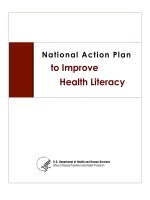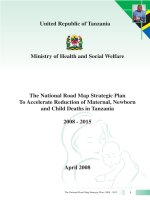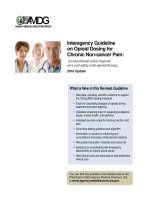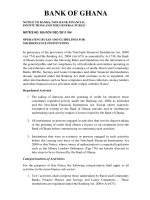Healthy Eating, Active Living: An action plan to improve diet, increase physical activity and tackle obesity (2008-2011) pdf
Bạn đang xem bản rút gọn của tài liệu. Xem và tải ngay bản đầy đủ của tài liệu tại đây (1.35 MB, 57 trang )
Healthy Eating, Active Living:
An action plan to improve diet, increase physical activity
and tackle obesity (2008-2011)
Healthy Eating, Active Living:
An action plan to improve diet, increase physical activity
and tackle obesity (2008-2011)
The Scottish Government, Edinburgh 2008
© Crown copyright 2008
ISBN: 978-0-7559-5768-2
The Scottish Government
St Andrew’s House
Edinburgh
EH1 3DG
Produced for the Scottish Government by RR Donnelley B56111 06/08
Published by the Scottish Government, June 2008
Further copies are available from
Blackwell’s Bookshop
53 South Bridge
Edinburgh
EH1 1YS
The text pages of this document are printed on recycled paper and are 100% recyclable
Contents
Foreword 2
1. Introduction 5
2. Trends and Habits in Scotland 9
3. Building on Success – Strategies, Targets and Goals 19
4. The Action Plan 25
4.1 Early Years 25
4.2 Schools and School Age Children 28
4.3 Adults and Workplaces 32
4.4 Older People 34
4.5 Communities 35
5. Delivery and Evaluating Success 43
6. Health Improvement Social Marketing Strategy 47
7. Developing a Longer Term Strategy to Tackle Obesity 51
References 52
Foreword
We believe that if we are to fulfil our purpose of creating a more
successful country, with opportunities for all of Scotland to flourish,
through increasing sustainable economic growth we must work
differently if we are to tackle some of the most complex and
intractable problems that face us. Obesity is one of the problems
that, like climate change, does not have a simple solution and
requires a new way of thinking. If we successfully tackle obesity then
we will reduce ill-health which will in turn contribute to sustainable
economic growth. As a new Administration we recognised that our
institutional structures could inhibit the development of comprehensive
policy required to tackle issues like obesity, therefore one of our first
actions was to reorganise the Scottish Government to align it more
closely with our strategic objectives and to promote closer working
across policy areas.
The problem of obesity has been a long time in the making and we cannot
expect to solve it quickly. Yet the fact that we have to solve it is clear if we
are to retain the gains we have made in reducing mortality from chronic
disease as well as limit the cost associated with treating the consequences
of obesity. We are also committed to focussing our efforts on those who
are most disadvantaged as we endeavour to reduce health inequalities.
For the first time we are publishing jointly the actions we are taking on diet
and physical activity over the next three years. We see greater opportunity
in making linkages stronger and more relevant, not just within this plan but
across wider Government activity. The actions identified in this plan on diet
and physical activity build on the good work that has gone before but we
have reinforced our drive in some key areas.
Over the next three years we will spend over £56m, of which £40m is new
money, on diet, physical activity and promoting healthy weight.
We are devoting nearly half of our new resources, over £19m, to the early
years. We want to strengthen our efforts to target women who are of a
child bearing age, pregnant mothers and preschool children, to improve
their nutrition as the evidence suggests that this is the best time to act if
we are to make the most significant impact.
We are doubling the expenditure on promoting physical activity to £12m.
This has allowed us to double the support for Paths to Health which already
has 20,000 people participating in volunteer led walks on a weekly basis.
For the first time we are devoting nearly £15m to programmes of activity to
support people achieve and maintain a healthy weight. NHS Health Boards
have already received the first instalment of £6m to support the
introduction of a child healthy weight intervention which we expect to
target 20,000 children over the next three years.
We are also supporting the roll out of Counterweight across Scotland from
2008.
Finally, we are working closely with COSLA and other partners to develop a
community based healthy weight intervention that ties together much of this
work in targeted areas.
We recognise that this plan in itself will not solve the obesity problem that this
country faces, nor will the new structures alone deliver change. We want to
engage with our key partners over the next few months to agree how we use
our new way of working to tackle obesity. Therefore, for the first time we are
committing the Government to the development of a longer term strategy
to tackle obesity. We believe that the steps we have made, in reshaping
the organisational structure of Government around our single purpose and
5 strategic objectives will provide a framework in which we can develop
solutions across Government and the public sector to tackle obesity.
NICOLA STURGEON
Deputy First Minister and Cabinet Secretary for Health and Wellbeing
SHONA ROBISON
Minister for Public Health
STEWART MAXWELL
Minister for Communities and Sport
2 | 3
Introduction
This paper outlines how the Scottish Government
will use the resources identified in the recent Scottish
Budget to improve the nation’s diet, encourage
greater physical activity and begin to establish a
base for tackling obesity through both targeted
interventions and by supporting us all in achieving
and maintaining a healthy weight. We have identified
key life stages and settings in which we will act.
Scotland has made significant progress in recent years
in reducing the number of deaths from chronic disease
which has resulted in an increase in life expectancy.
1
However, there is concern that the impact of rising levels
of overweight and obese people will reverse that
progress.
4 | 5
In addition, it has been estimated that the cost to the NHS in Scotland of
obesity in 2003 was £171m.
2
More recently the Foresight Report by the
UK Government Office for Science, Tackling Obesities (2007)
3
stated that
if current trends are to continue across the UK at the present rate then
by 2050 it is estimated the cost to the UK’s health service will be almost
£50 billion at today’s prices.
Scotland has previously established strong foundations and has made
progress through implementation of the existing diet
4
and physical activity
5
strategies. In this joint action plan we re-affirm our commitment to these
strategies and we identify the immediate short-term actions that we believe
will best contribute to improving our diet, increasing our levels of physical
activity, and helping to tackle obesity. To support our actions we have identified
an additional £40m for the period 2008-2011 on top of the existing £16m
previously allocated to support action on diet, physical activity and obesity.
Obesity is a complex problem. This was recently made clear in the Foresight
Report which provided evidence that the causes and determinants of obesity
are broad ranging and involve complex interactions of cultural, social,
environmental and lifestyle factors. As a Government we are committed to
reversing the increase in the incidence of obesity. We accept in principle
the conclusions of the Foresight Report and we will use the Report as a
basis for developing Scotland’s longer-term strategy for tackling obesity. In
the coming months we will engage with our partners from all sectors of
Scottish life to help develop a longer-term strategy for tackling obesity.
Healthy Eating, Active Living:
An action plan to improve diet, increase physical activity and tackle obesity (2008-2011)
Chapter 1
Introduction
Food policy is just one example of the way in which diverse stakeholders,
sectors and disciplines can play a part in shaping our contemporary
environment either to promote or to tackle unhealthy weight. The
development of a National Food and Drink Policy provides us with an
opportunity to reshape and influence the environment in which food is
produced, processed and eventually finds its way on to our plates and an
early opportunity to demonstrate how as a Government we can work
across traditional boundaries to effect change.
Choosing the Right Ingredients carried forward themes highlighted in the
Review of the Scottish Diet Action Plan
6
about closer integration between
the policy goals of improving Scotland’s diet-related ill-health and those of
social justice, sustainable development and agriculture. It also highlighted a
need to refresh engagement with the food industry. The discussion on
Choosing the Right Ingredients has concluded and first reflections on the
outcomes have been shared, but clearly if we are to maximise our
opportunity to change what we consume then the National Food and Drink
Policy has to reflect our ambitions for improving the nation’s health through
improving its diet.
6 | 7
Trends and Habits in Scotland
The following section provides a brief illustration of
the position in Scotland with regard to our dietary
and physical activity habits and begins with some of
the consequences of those habits.
Trends in obesity among children in Scotland
The increase in prevalence of obesity among children is not a recent
phenomenon. Between the late 1960s and early 1990s in Scotland, the
percentage of primary school children (aged 4-6 years) who were overweight
or obese was generally higher than would be expected according to the
UK reference standard. The most recent data for school children at Primary
1 (2006) suggests that the level of overweight and obesity in this age group
may be levelling out, but that it is still much higher than expected. See
Figure 1.
Figure 1
Trend in Overweight Primary 1 School Children
Source: 1968-1993 SMR10 School Health Record; 2001-2006 Child Health Surveillance
Programme ISD Scotland.
Note: The “selected areas” for which trends in overweight are plotted on the chart are
NHS Health Borders, Fife, Lanarkshire and Lothian. These areas continuously monitored
overweight in P1 children using SRM10 1968-1993 and then using CHSP 2001-2006.
The CHSP-School figures published include different NHS Health Boards for different
years (as not all NHS Health Boards implemented the system at the same time).
8 | 9
0
5
10
15
20
25
1968 1970 1972 1974 1976 1978 1980 1982 1984 1986 1988 1990 1992 1994 1996 1998 2000 2002 2004 2006
School Year ending June:
%
CHSP-School Selected Areas (C) School Health (SMR10) Selected Areas (B)
School Health (SMR10) All 15 Boards (A) CHSP-School as published (D)
1990 UK Reference Standard
(based on data from 1978-1990)
Data from the Scottish Health Survey indicate that between 1998 and 2003,
estimates of prevalence of unhealthy weight (underweight or overweight/
obese) among boys aged 2-15 years increased, whilst for girls there was
little change over the same time period. See Table 1.
Table 1
Prevalence of children with Body Mass Index outside a
healthy range
1998 2003
%%
Boys aged 2-15y 28.9 33.7
Girls aged 2-15y 30.3 30.4
Both sexes aged 2-15y 29.6 32.1
Source: Scottish Health Survey
Healthy Eating, Active Living:
An action plan to improve diet, increase physical activity and tackle obesity (2008-2011)
Chapter 2
Trends and Habits in Scotland
10 | 11
Trends in obesity among adults in Scotland
The Scottish Health Survey indicates that for adults aged 16-64 years
there has been a rising trend in overweight and obesity between 1995 and
2003. See Table 2.
Table 2
Prevalence of overweight and obesity in adults aged
16-64 years
1995 1998 2003
%%%
Men – overweight,
including obese (BMI >= 25) 55.6 61.0 64.0
Men – obese (BMI >= 30) 15.9 18.8 22.0
Women – overweight,
including obese (BMI >= 25) 47.2 52.2 57.3
Women – obese (BMI >= 30) 17.3 20.9 23.8
Source: Scottish Health Survey
Predicting long term trends for prevalence of obesity is complex because
many variables are unknown. However extrapolating from current trends
the Foresight Report predicts that obesity levels across the UK could be at
60% in men and 50% in women by 2050.
Current Dietary Patterns in the Scottish Population
A review of dietary intakes in Scotland
6
has indicated that although some
progress has been made towards reducing total fat intake since 1996, there
has been no change in the intake of saturated fat, fruit and vegetables, bread,
oil rich fish and breakfast cereals. Furthermore the data indicates that there
appears to have been an increase in the consumption of added sugars.
There are also marked differences in diet between affluent and deprived areas.
For example, with regard to fruit and vegetable consumption, females in
the least deprived areas are twice as likely to consume the recommended
5 or more portions per day than those in the most deprived areas (30%
compared to 13%) (Scottish Health Survey 2003)
7
. A similar picture emerges
for males, with 26% consuming the recommended levels in the least deprived
areas compared with 12% in the most deprived areas. The same pattern is
seen when examining Scottish data from the Expenditure and Food Survey
8
.
Figure 2
Proportion of adults eating 5+ portions of fruit and
vegetables a day and mean number of portions
consumed per day (Scottish Health Survey 2003)
Source: Scottish Health Survey
For children aged 5-15 these patterns are continued. Children in the most
deprived areas were more likely to consume sweets/chocolates or non-diet
soft drinks at least once a day, chips and meat products at least twice a
week, and to add salt to their food than those in the least deprived areas.
They were also less likely to consume 2-3 slices of high fibre bread a day;
potatoes, pasta or rice at least 5 days a week; poultry at least twice a
week; white or oily fish at least once a week; and to use low fat milk or to
take dietary supplements than those in the least deprived areas. (Scottish
Health Survey 2003)
Healthy Eating, Active Living:
An action plan to improve diet, increase physical activity and tackle obesity (2008-2011)
0
10
20
30
40
50
16-24y 25-34y 35-44y 45-54y 55-64y 65-74y 75+y
Age group
% adults
0
1
2
3
4
5
Mean no. portions
Men - 5+ portions a day
Women - 5+ portions a day
Men - Mean portions per day
Women - Mean portions per day
Chapter 2
Trends and Habits in Scotland
12 | 13
%
0
10
20
30
40
50
60
70
80
47
73
30
57
37
68
39
70
26
54
17
28
Eats sweets
and chocolates
Drinks non-diet
soft drinks
Eats crisps/
savoury snacks
Eats chips
Eats meat
products
Adds salt
at the table
Once a day or more 2+ times a week Usually
SIMD5 least deprived
SIMD1 most deprived
Figure 3
Regular consumption of energy dense food and added salt
– Girls aged 2-15y, by deprivation
(Scottish Health Survey 2003)
Source: Scottish Health Survey
Figure 4
Regular consumption of energy dense food and added salt
– Boys aged 2-15y, by deprivation
(Scottish Health Survey 2003)
Source: Scottish Health Survey
%
67
51
38
62
42
59
44
69
35
60
9
28
Eats sweets
and chocolates
Drinks non-diet
soft drinks
Eats crisps/
savoury snacks
Eats chips
Eats meat
products
Adds salt
at the table
Once a day or more 2+ times a week Usually
SIMD5 least deprived
SIMD1 most deprived
0
10
20
30
40
50
60
70
80
Current Physical Activity Patterns in the Scottish Population
To meet the national 2022 physical activity target the percentage of the
population meeting current recommendations will need to increase
annually by an average of 1%. Despite the overwhelming benefits of
physical activity, prevalence levels are still low in Scotland.
Figure 5
Proportion of adults meeting the current physical activity
recommendations (30+ minutes on 5+ days a week)
(Scottish Health Survey 2003)
Source: Scottish Health Survey
Figure 6
Proportion of children meeting the current physical
activity recommendations (at least 60 minutes a day)
(Scottish Health Survey 2003)
Source: Scottish Health Survey
Healthy Eating, Active Living:
An action plan to improve diet, increase physical activity and tackle obesity (2008-2011)
%
77
70
75
75
77
75
78
57
41
68
Boys
Girls
2-4y 5-7y 8-10y 11-12y
Age Group
13-15y
0
10
20
30
40
50
60
70
80
%
59
36
57
40
45
39
40
35
35
28
23
16
13
6
Men
Women
16-24y 25-34y 35-44y 45-54y
Age Group
55-64y 65-74y 75+y
0
10
20
30
40
50
60
70
80
Chapter 2
Trends and Habits in Scotland
14 | 15
Only 39% of Scottish adults and 69% of Scottish children currently meet existing guidelines.
Within these figures specific groups of the population remain particularly inactive. These
include women of all ages (particularly adolescent girls) and older adults. There is some room
for optimism however. Comparing the data from the Scottish Health Survey in 2003 to that
derived from the 1998 Survey, the percentage of adults meeting the recommendations
significantly increased. The percentage of children meeting the recommendations also
showed an increase over this period, although the increase was not statistically significant.
As a means of transport:
No days 48.2 46.9 45.4 45.7 46.4 46.6 47.1 46.8
1-2 days 18.7 18.4 19.1 18.2 17.2 16.6 15.2 15.6
3-5 days 17.9 20.4 21.4 21.9 21.7 21.1 21.7 20.9
6-7 days 15.1 14.3 14.1 14.2 14.7 15.7 16.0 16.6
1+ days 51.8 53.1 54.6 54.3 53.6 53.4 52.9 53.2
All 100 100 100 100 100 100 100 100
1999 2000 2001 2002 2003 2004 2005 2006
column percentages
Just for pleasure:
No days 60.3 58.7 57.4 59.3 56.4 56.4 54.1 53.4
1-2 days 15.8 16.6 17.9 17.7 17.4 16.1 16.6 16.3
3-5 days 10.5 11.7 12.0 10.8 12.4 13.2 14.2 13.8
6-7 days 13.5 12.9 12.7 12.1 13.8 14.3 15.1 16.4
1+ days 39.7 41.3 42.6 40.7 43.6 43.6 45.9 46.6
All 100 100 100 100 100 100 100 100
S
S
a
a
m
m
p
p
l
l
e
e
s
s
i
i
z
z
e
e
(
(
=
=
1
1
0
0
0
0
%
%
)
)
13,768 14,533 14,643 14,041 13,936 14,737 7,001 7,111
Table 3
Adults (16+) – frequency of walking in the previous seven days*
*The number of days in the previous seven days on which the person made a trip of more than a quarter of a mile
by foot for the specified purpose.
The figures here exclude those who said “don't know”, and count those who said “unable to walk” as walking on
none of the previous seven days.
Healthy Eating, Active Living:
An action plan to improve diet, increase physical activity and tackle obesity (2008-2011)
Table 4
The prevalence of obesity and related diseases and the number of
people who have each condition as a result of obesity
(p) = prevalence, (i) = incidence
Disease Estimated Estimated Estimated
number in proportion number in
Scotland annual attributable Scotland
incidence/ to obesity attributable to
prevalence obesity (2003)
Cardiovascular Number Percentage Number
■ Hypertension 1,329,696 (p) 36 478,691
■ Angina pectoris 250,344 (p) 15 37,552
■ Myocardial Infarction 135,432 (p) 18 24,378
■ Stroke 92,340 (p) 6 5,540
Endocrine
■ Type 2 diabetes 73,872 (p) 47 34,720
Neoplastic
■ Colon cancer 2,242 (i) 29 650
■ Ovarian cancer 616 (i) 13 80
■ Cancer of the Uterus 449(i) 14 63
Musculo-skeletal
■ Osteoarthritis 118,500 (p) 12 14,220
■ Gout 20,150 (p) 47 9,470
Gastro-intestinal
■ Gallstones 11,350 (p) 15 1,702
Why does it matter?
People who are overweight or obese have an increased risk of a wide range of serious
diseases: the greater the amount of overweight, the greater the risk to the individual.
Indeed being obese has been shown to double the risk of dying among men and
increased the risk of death among women by 60%.
9
Table 4 below taken from the recent
ScotPHO epidemiology briefing report
10
highlights the numbers in Scotland suffering from
particular disease with an estimate of those that can be directly linked to obesity.
Chapter 2
Trends and Habits in Scotland
16 | 17
Health Inequalities
The most recent evidence, from the 2003 Scottish Health Survey, indicates
no clear or simple correlation between deprivation and obesity across the
population generally. Only amongst adult women is there a clear linear pattern
of increasing obesity with increasing deprivation, ranging from 20.7% obese
in the least deprived fifth of areas to 31.8% obese in the most deprived. This
may be partly explained by the diet and physical activity levels in deprived
areas as measured by the Scottish Health Survey. While clearly deprived
people have the poorest diet there is not such a straightforward correlation
between deprivation and physical activity although there are gender
differences which further complicate the picture.
The Foresight Report indicates that this disparity between the sexes in
respect of the relationship between obesity and deprivation may persist in
future UK-wide trends. It suggests that UK obesity levels amongst adult
women in the least deprived category may increase by between 10% and
15% by 2050, while obesity levels for women in the most deprived category
may increase from 25% to 62%. In contrast only a modest social gradient
is forecast for increases in obesity amongst adult men.
The Foresight Report recognises that obesity is not exclusively a problem
related to social class or inequality. It suggests that to assume that it is
primarily a feature of lower-income groups is to disguise the society-wide
character of the epidemic. However, efforts to combat obesity in lower-
income groups will have positive consequences for both health and
inequality. The impacts of the chronic conditions associated with obesity
may be compounded by other health behaviours, such as poor diet,
physical inactivity, smoking or lower levels of breastfeeding.
We have already stated in Better Health Better Care
11
that our top priority
in improving the health of the nation is to tackle health inequalities. The
Ministerial Task Force on Health Inequalities
12
published its report and
recommendations on 19 June 2008. The actions set out in this document
to improve diet, increase physical activity and support people to
achieve and maintain a healthy weight are targeted mainly towards
those at greatest risk of health inequalities.
Building on Success – Strategies,
Targets and Goals
In Scotland we have well established strategies to
improve our diet and encourage greater physical
activity. Eating for Health – A Diet Action Plan for
Scotland (1996) identified practical measures across
the food supply chain to support improvement in our
diet. It also set out dietary targets and a number of
recommendations aimed at reducing dietary related
morbidity and mortality in Scotland. These were
endorsed by Improving Health in Scotland – The
Challenge (2003)
13
and Eating for Health – Meeting
the Challenge (2004).
14
The National Physical Activity
Strategy (2003)
15
endorsed international
recommendations for the quantity and quality of
physical activity required for a health benefit.
18 | 19
Healthy Eating, Active Living:
An action plan to improve diet, increase physical activity and tackle obesity (2008-2011)
The broad objectives of the current physical activity and diet strategies are
to:
■ Create, improve and maintain the supply of natural and built environments
encouraging more active lifestyles (this includes opportunities for walking,
cycling and informal recreation space as well as formal leisure centres,
sports fields or swimming pools);
■ Develop, increase and maintain capacity in a wide range of settings and
sectors to support people to become more active;
■ Stimulate interest in and demand for increased participation in physical
activity by raising awareness in the general population and relevant
professional groups about the health and wellbeing benefits and the
recommended guidelines for achieving these;
■ Promote healthy food choices, meal preparation and eating habits by
communicating practical achievable steps towards the consumption
of a healthier diet;
■ Increase access to healthier food choices, particularly for those on low
incomes and provide support, education and skill development to allow
people to break through the barriers of food affordability and availability,
and the negative impact of culture and lack of food skills;
■ Work with the food manufacturing, processing and retailing industries to
further develop and promote healthier choices;
■ Ensure that primary food producers at both national and local level
contribute fully to the achievement of Scottish dietary goals; and
■ Monitor impact of current activity and ensure current policy and practice
are supported by best available evidence.
We will continue to monitor progress in implementation of the physical
activity and diet strategies through existing and new targets. The current
targets for physical activity described in the strategy are left unaltered.
National Physical Activity Strategy
The National Physical Activity Strategy included the target that by 2022,
50% of adults and 80% of children will be expected to meet the current
recommended levels of physical activity and that adults should accumulate at
least thirty minutes of moderate intensity activity on most days of the week and
that children should accumulate at least one hour of moderate intensity activity
on each day of the week.
Chapter 3
Building on Success – Strategies, Targets and Goals
20 | 21
The review of the Scottish Diet Action Plan
9
highlighted that progress in
some areas was slow and that the dietary targets are not being achieved
as the level of change defined by these targets had underestimated the
impact of inequalities to achieve population level impact.
We still believe that the underlying principles and goals established in the
Scottish Diet Action Plan remain valid and that the failure to progress as
quickly as hoped on dietary targets is not sufficient reason to change the
overall thrust of the strategy. However, given the current dietary targets are
time-limited (up to 2010), we are currently considering a more pragmatic
approach of adopting a set of longer term dietary goals which we will use
to underpin our diet policy initiatives. The existing dietary targets are shown
in Table 5.
Healthy Eating, Active Living:
An action plan to improve diet, increase physical activity and tackle obesity (2008-2011)
Fruit & Vegetables Average intake to double to more than 400g per
day
Bread Intake to increase by 45% from present daily
intake of 106g, mainly using wholemeal and
brown breads
Breakfast Cereals Average intake to double from the present intake
of 17g per day
Fats Average intake of total fat to reduce from 40.7%
to no more than 35% of food energy
Average intake of saturated fatty acids to reduce
from 16.6% to no more than 11% of food energy
Salt Average intake to reduce from 163mmol per day
to 100mmol per day
Sugar Average intake of NME sugars in adults not to
increase
Average intake of NME sugars in children to
reduce by half i.e. to less than 10% of total
energy
Breastfeeding See breakout box on page 27
Total Complex Carbohydrates Increase average non-sugar carbohydrates intake
by 25% from 124g per day, through increased
consumption of fruits and vegetables, bread,
breakfast cereals, rice and pasta and through an
increase of 25% in potato consumption
Fish White fish consumption to be maintained at
current levels
Oil rich fish consumption to double from 44g to
88g per week
Table 5: Scottish Diet Action Plan – Dietary Targets









